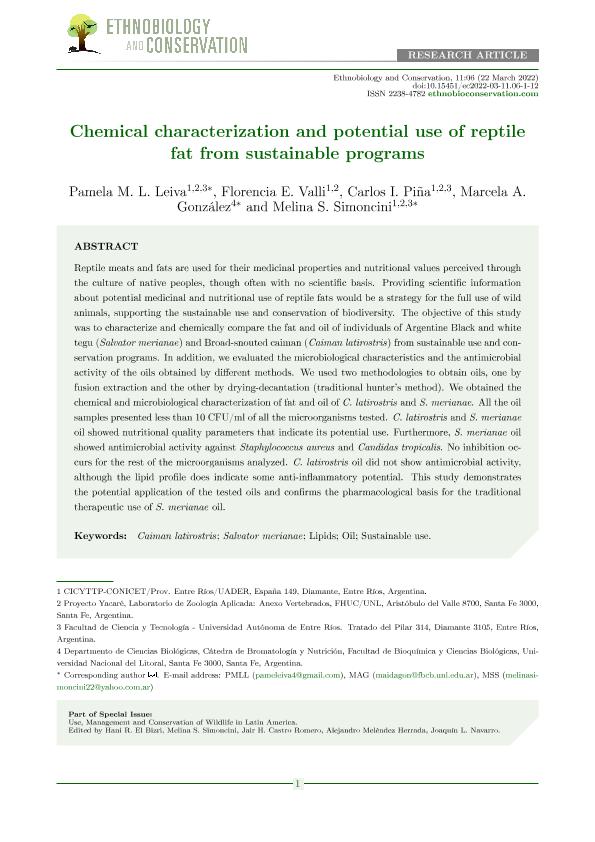Mostrar el registro sencillo del ítem
dc.contributor.author
Leiva, Pamela Maria de Lujan

dc.contributor.author
Valli, Florencia Elizabeth

dc.contributor.author
Piña, Carlos Ignacio

dc.contributor.author
González, Marcela Aída

dc.contributor.author
Simoncini, Melina Soledad

dc.date.available
2023-10-03T15:54:33Z
dc.date.issued
2022-03
dc.identifier.citation
Leiva, Pamela Maria de Lujan; Valli, Florencia Elizabeth; Piña, Carlos Ignacio; González, Marcela Aída; Simoncini, Melina Soledad; Chemical characterization and potential use of reptile fat from sustainable programs; Universidade Federal Rural de Pernambuco; Ethnobiology and Conservation; 11; 6; 3-2022; 1-12
dc.identifier.issn
2238-4782
dc.identifier.uri
http://hdl.handle.net/11336/213973
dc.description.abstract
Reptile meats and fats are used for their medicinal properties and nutritional values perceived through the culture of native peoples, though often with no scientific basis. Providing scientific information about potential medicinal and nutritional use of reptile fats would be a strategy for the full use of wild animals, supporting the sustainable use and conservation of biodiversity. The objective of this study was to characterize and chemically compare the fat and oil of individuals of Argentine Black and white tegu (Salvator merianae) and Broad-snouted caiman (Caiman latirostris) from sustainable use and conservation programs. In addition, we evaluated the microbiological characteristics and the antimicrobial activity of the oils obtained by different methods. We used two methodologies to obtain oils, one by fusion extraction and the other by drying-decantation (traditional hunter’s method). We obtained the chemical and microbiological characterization of fat and oil of C. latirostris and S. merianae. All the oil samples presented less than 10 CFU/ml of all the microorganisms tested. C. latirostris and S. merianae oil showed nutritional quality parameters that indicate its potential use. Furthermore, S. merianae oil showed antimicrobial activity against Staphylococcus aureus and Candidas tropicalis. No inhibition occurs for the rest of the microorganisms analyzed. C. latirostris oil did not show antimicrobial activity, although the lipid profile does indicate some anti-inflammatory potential. This study demonstrates the potential application of the tested oils and confirms the pharmacological basis for the traditional therapeutic use of S. merianae oil.
dc.format
application/pdf
dc.language.iso
eng
dc.publisher
Universidade Federal Rural de Pernambuco
dc.rights
info:eu-repo/semantics/openAccess
dc.rights.uri
https://creativecommons.org/licenses/by-nc-sa/2.5/ar/
dc.subject
CAIMAN LATIROSTRIS
dc.subject
SALVATOR MARINAE
dc.subject
LIPIDS
dc.subject
OIL
dc.subject.classification
Otras Ciencias Biológicas

dc.subject.classification
Ciencias Biológicas

dc.subject.classification
CIENCIAS NATURALES Y EXACTAS

dc.title
Chemical characterization and potential use of reptile fat from sustainable programs
dc.type
info:eu-repo/semantics/article
dc.type
info:ar-repo/semantics/artículo
dc.type
info:eu-repo/semantics/publishedVersion
dc.date.updated
2023-07-06T22:41:44Z
dc.journal.volume
11
dc.journal.number
6
dc.journal.pagination
1-12
dc.journal.pais
Brasil

dc.journal.ciudad
Pernambuco
dc.description.fil
Fil: Leiva, Pamela Maria de Lujan. Provincia de Entre Ríos. Centro de Investigaciones Científicas y Transferencia de Tecnología a la Producción. Universidad Autónoma de Entre Ríos. Centro de Investigaciones Científicas y Transferencia de Tecnología a la Producción. Consejo Nacional de Investigaciones Científicas y Técnicas. Centro Científico Tecnológico Conicet - Santa Fe. Centro de Investigaciones Científicas y Transferencia de Tecnología a la Producción; Argentina. Universidad Nacional del Litoral. Facultad de Humanidades y Ciencias. Departamento de Ciencias Naturales. Laboratorio de Zoología Aplicada: Anexo Vertebrados (FHUC-UNL/MASPyMA); Argentina. Universidad Autónoma de Entre Ríos. Facultad de Ciencia y Tecnología; Argentina
dc.description.fil
Fil: Valli, Florencia Elizabeth. Provincia de Entre Ríos. Centro de Investigaciones Científicas y Transferencia de Tecnología a la Producción. Universidad Autónoma de Entre Ríos. Centro de Investigaciones Científicas y Transferencia de Tecnología a la Producción. Consejo Nacional de Investigaciones Científicas y Técnicas. Centro Científico Tecnológico Conicet - Santa Fe. Centro de Investigaciones Científicas y Transferencia de Tecnología a la Producción; Argentina. Universidad Nacional del Litoral. Facultad de Humanidades y Ciencias. Departamento de Ciencias Naturales. Laboratorio de Zoología Aplicada: Anexo Vertebrados (FHUC-UNL/MASPyMA); Argentina
dc.description.fil
Fil: Piña, Carlos Ignacio. Provincia de Entre Ríos. Centro de Investigaciones Científicas y Transferencia de Tecnología a la Producción. Universidad Autónoma de Entre Ríos. Centro de Investigaciones Científicas y Transferencia de Tecnología a la Producción. Consejo Nacional de Investigaciones Científicas y Técnicas. Centro Científico Tecnológico Conicet - Santa Fe. Centro de Investigaciones Científicas y Transferencia de Tecnología a la Producción; Argentina. Universidad Nacional del Litoral. Facultad de Humanidades y Ciencias. Departamento de Ciencias Naturales. Laboratorio de Zoología Aplicada: Anexo Vertebrados (FHUC-UNL/MASPyMA); Argentina. Universidad Autónoma de Entre Ríos. Facultad de Ciencia y Tecnología; Argentina
dc.description.fil
Fil: González, Marcela Aída. Universidad Nacional del Litoral. Facultad de Bioquímica y Ciencias Biológicas. Departamento de Ciencias Biológicas. Cátedra de Bromatología y Nutrición; Argentina
dc.description.fil
Fil: Simoncini, Melina Soledad. Provincia de Entre Ríos. Centro de Investigaciones Científicas y Transferencia de Tecnología a la Producción. Universidad Autónoma de Entre Ríos. Centro de Investigaciones Científicas y Transferencia de Tecnología a la Producción. Consejo Nacional de Investigaciones Científicas y Técnicas. Centro Científico Tecnológico Conicet - Santa Fe. Centro de Investigaciones Científicas y Transferencia de Tecnología a la Producción; Argentina. Universidad Nacional del Litoral. Facultad de Humanidades y Ciencias. Departamento de Ciencias Naturales. Laboratorio de Zoología Aplicada: Anexo Vertebrados (FHUC-UNL/MASPyMA); Argentina. Universidad Autónoma de Entre Ríos. Facultad de Ciencia y Tecnología; Argentina
dc.journal.title
Ethnobiology and Conservation
dc.relation.alternativeid
info:eu-repo/semantics/altIdentifier/doi/https://doi.org/10.15451/ec2022-03-11.06-1-12
dc.relation.alternativeid
info:eu-repo/semantics/altIdentifier/url/https://www.ethnobioconservation.com/index.php/ebc/article/view/601
Archivos asociados
